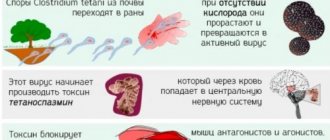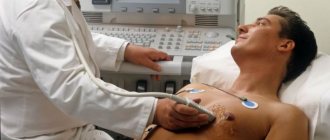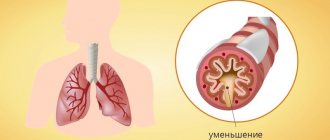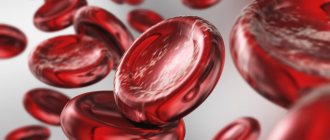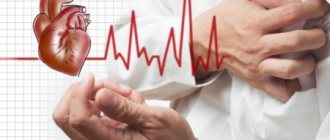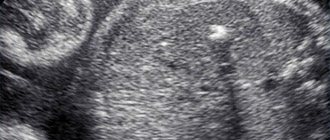Almost everyone is familiar with the feeling of shortness of breath when running or climbing stairs.
But there are cases when shortness of breath occurs when walking only a few tens of meters or even at rest. If in such situations it becomes difficult to breathe, then the matter is serious.
Breathing is a natural process, so we don’t notice it. But we immediately feel if there is something wrong with our breathing. Especially when, out of the blue, we start to choke. The brain receives a corresponding signal, and our breathing quickens, and this process cannot be controlled by consciousness. Its frequency and rhythm, the duration of inhalation or exhalation have changed - in a word, you feel that something is clearly wrong with your breathing. This is shortness of breath.
Why is it hard to breathe - the body’s reaction
In many cases, shortness of breath situations can be an indicator of serious illness. Therefore, one cannot ignore such a deviation and wait until the next attack passes in the hope that a new one will not happen again soon.
Almost always, if there is not enough air when inhaling, the reason lies in hypoxia - a drop in oxygen content in cells and tissues. It could also be due to hypoxemia, when oxygen drops in the blood itself.
Each of these deviations becomes the main factor why activation begins in the brain's respiratory center, heartbeat and breathing become more frequent. In this case, gas exchange in the blood with atmospheric air becomes more intense and oxygen starvation decreases.
Almost every person experiences a feeling of lack of oxygen while running or other physical activity, but if this happens even with a calm step or at rest, then the situation is serious. Any indicators such as changes in breathing rhythm, shortness of breath, duration of inhalation and exhalation should not be ignored.
The respiratory system of the human body is vulnerable to infections, so bronchopulmonary diseases are widespread. Pneumonia (pneumonia) affects up to 25% of the adult population. Read more in the article: “pneumonia in an adult with fever.”
Shortness of Air: Case Studies
Woman, 32 years old, entrepreneur.
From the anamnesis: over the past five to seven years, I worked very hard, practically never rested. A month before the first complaints appeared, she gave birth to a child (caesarean section). She did not tolerate anesthesia well (long awakening, headaches, drowsiness). A week after giving birth, an episode of “shortness of air” occurred.
I contacted our clinic in November 2011. The main complaint is a constant feeling of shortness of breath when breathing, aggravated by excitement, while talking with other people (“I can either breathe or talk”), as well as when walking, in enclosed spaces or public places.
Also about chills, unstable blood pressure, rapid resting pulse (up to 130 beats per minute). I developed a cold allergy (nasal congestion when going outside in the autumn-winter period).
The woman underwent 2 courses of therapy. There are currently no symptoms.
Female, 27 years old, journalist
The onset of his illness is associated with the stress he experienced. Before her eyes, her father suddenly dies, who, in her words, was an absolutely healthy person.
Just a few days after the funeral, she develops a classic panic attack with severe weakness, a feeling of shortness of breath when inhaling, shortness of breath and palpitations. Shortness of breath also tormented the patient during the interictal period. So, at the clinic appointment, she was noticeably breathing heavily, spoke with pauses, resting for a long time after several spoken phrases.
After the examination, a diagnosis of severe dysfunction of the autonomic nervous system was made.
After the first course of therapy, panic attacks stopped completely. A repeated course helped to cope with residual manifestations of the disease in the form of episodes of lack of air when breathing.
Feelings of fear and anxiety Presyncope, weakness Sweating, sweating, heavy sweat Prolonged low-grade fever Sleep disorder, insomnia, drowsiness Chronic fatigue syndrome Headaches Constant heaviness in the head
Muscle tone, spasm of the neck muscles Weather dependence Lack of air, heavy breathing Strong heartbeat, rapid pulse Burning in the abdomen, pain in the stomach Discomfort in the intestines, diarrhea Urinary incontinence Blurred vision, vision problems
Types of shortness of breath and other data on the disease
Dyspnea or non-medical language
– shortness of breath is a disease that is accompanied by a feeling of lack of air. In the case of heart problems, the appearance of shortness of breath begins during physical exertion in the early stages, and if the situation gradually worsens without treatment, even in a relative state of rest.
This is especially evident in a horizontal position, which forces the patient to constantly sit.
| Mechanical blockage | Anemia | Ischemic disease | Traumatic brain injury | |
| Character of shortness of breath | Mixed | Mixed | It’s hard to breathe, breathing with bubbling sounds | Mixed, arrhythmic breathing |
| When does it occur | When a foreign body blockage occurs | Some time after the start of observation | Most often at night | After some time has passed since the injury |
| Duration, course | Immediate sudden onset of shortness of breath | Gradual long-term progression | In the form of attacks lasting from a couple of minutes to several hours | Depending on the degree of brain damage |
| Appearance | Depending on the severity of breathing difficulty | Pale skin, cracked corners of the mouth, brittle hair and nails, dry skin | Bluish hands and feet, cold to the touch, possible swelling in the abdomen, legs, swelling of the veins of the neck | Convulsions and paralysis are possible |
| Position | Any | Any | Half-sitting or with legs down | Any |
| Sputum | Absent | Absent | Heavy phlegm | Absent |
| Associated conditions | In cases where the foreign body has been present for more than a day, inflammation may begin. | Difficulty swallowing dry food, constipation | Heart diseases | Trauma and loss of consciousness |
| Age | Most often children's | Any | Elderly and middle | Most often middle and young |
Manifesting itself as attacks of severe shortness of breath most often at night, the deviation may be a manifestation of cardiac asthma. In this case, breathing becomes difficult and this is an indicator of inspiratory dyspnea. The expiratory type of shortness of breath is when, on the contrary, it is difficult to exhale air.
Each of us is familiar with the cold, and the onset of the disease is associated with general malaise, cough and sore throat. However, discomfort in the larynx is not always associated with a virus or hypothermia, and it is important to correctly diagnose the source of the sore throat, since further treatment depends on this. Read more in the article: “how to treat a sore throat and dry cough.”
This happens due to a narrowing of the lumen in the small bronchi or in case of loss of elasticity in the lung tissues. Directly cerebral dyspnea manifests itself due to irritation of the respiratory center, which can occur as a result of tumors and hemorrhages.
Difficulty or rapid breathing
Advertising:
Depending on the frequency of respiratory contractions, there may be 2 types of shortness of breath:
- bradypnea
– respiratory movements per minute of 12 or less, occurs due to damage to the brain or its membranes, when hypoxia lasts for a long time, which can be accompanied by diabetes mellitus and diabetic coma; - tachypnea
- shallow and rapid breathing (more than 20 respiratory movements per minute), accompanied by blood diseases, anemia or fever.
The main criterion that shortness of breath is pathological is that it occurs under normal conditions and light loads, when it was previously absent.
"I can not breathe!" The pulmonologist explained why the coronavirus reminds itself a month later
— Will it be right if, after suffering from covid pneumonia, we start playing sports again as before in order to restore our lungs?
— Not really, after any acute illness that is accompanied by damage to the lung tissue, you need to gradually increase physical activity. Swimming in the pool is very useful for such patients, while the respiratory muscles work. But the basis of rehabilitation is the restoration of proper breathing. The first thing we teach in our consultations is breathing exercises, in particular diaphragmatic breathing.
It is with this type of breathing that the maximum saturation of the lungs with oxygen occurs. In fact, this is a very physiological type of breathing. Babies breathe this way; with age, this is lost. This is our most important recommendation; it is suitable for patients with psychogenic shortness of breath and for those who have changes in the lungs. It is also necessary to perform physical exercises: for the upper muscle group - exercises with dumbbells, exercises for muscular endurance, walking on stairs is also useful, you can use step platforms (steppers) at home. In our center, having several rehabilitation programs, we try to approach each patient individually, solving his breathing problems. All the methods we offer were developed by federal experts in the field of respiratory rehabilitation and experts from the World Health Organization. On average, exercise should be 20-30 minutes a day at least five times a week. Exercise increases blood flow and diaphragmatic breathing saturates the lungs with oxygen. All this prevents the formation of fibrous tissue in the lungs.
— How to understand whether physical activity is sufficient or not?
— There is a simple method from WHO experts. For example, at the height of physical activity, cross-country, say any phrase or sentence. Any: “Exercising is very good for me.” If you cannot pronounce a sentence without stopping, in its entirety, it means that the physical activity is excessive. If you pronounce the phrase with ease, the load is insufficient. If you stop slightly, after two or three words, this is an adequate load. But I repeat, if you haven’t run cross-country before, you shouldn’t start doing it immediately after a coronavirus infection. The most ideal thing, besides our professional rehabilitation complexes, is walking. This is available to everyone. We recommend walking 30 minutes to two hours a day. Moreover, we recommend planning all physical exercises and walks in the afternoon. This gives pleasant fatigue and promotes deeper and more complete sleep. And proper sleep is a very important part of any rehabilitation methods. It is during sleep that the body recovers after illness. We tell our patients a lot about quality sleep: complete darkness, all windows are curtained, comfortable temperature in the room - 19-23 degrees. The duration of night sleep should be at least 7–8 hours. And very important: falling asleep between 22 and 23 hours. This is the key to quality sleep and full recovery.
Physiology of the respiratory process and why there may be problems
When it is difficult to breathe and there is not enough air, the reasons may be a disruption of complex processes at the physiological level. Oxygen enters our body, into the lungs and spreads to all cells thanks to surfactant.
This is a complex of various active substances (polysaccharides, proteins, phospholipids, etc.) lining the alveoli of the lungs. Responsible for ensuring that the lung bubbles do not stick together and oxygen freely enters the lungs.
The value of surfactant is very significant - with its help, the spread of air through the alveolar membrane is accelerated 50-100 times. That is, we can say that we can breathe thanks to surfactant.
The less surfactant, the more difficult it will be for the body to ensure normal respiratory processes.
Advertising:
Surfactant helps the lungs absorb and absorb oxygen, prevents the lung walls from sticking together, improves immunity, protects the epithelium and prevents edema. Therefore, if there is a constant feeling of oxygen starvation, it is quite possible that the body is unable to ensure healthy breathing due to failures in the production of surfactant.
Possible causes of the disease
Often a person may feel: “I’m suffocating, as if there’s a stone on my lungs.” In good health, this situation should not occur in a normal state of rest or in the case of light exertion. The reasons for lack of oxygen can be very diverse:
- strong emotions and stress;
- allergic reaction;
- lung disease;
- diseases of the cardiovascular system;
- physical inactivity;
- compression of the walls in the sternum;
- obesity;
- bad habits such as smoking and alcohol abuse;
- hernia;
- sudden change in environment.
Despite such a large list of possible reasons why it may be difficult to breathe, surfactant is almost always at the root of the problem. If we consider from a physiological point of view, this is the fatty membrane of the inner walls of the alveoli.
Advertising:
The alveolus is a vesicular depression in the lungs and is involved in the respiratory act. Thus, if everything is in order with the surfactant, any diseases on the lungs and breathing will be minimally reflected.
Therefore, if we see people in transport, pale and in a faint state, most likely it’s all about the surfactant. When a person notices: “I yawn too often,” it means the substance is not being produced correctly.
How to avoid problems with surfactant
It has already been noted that the basis of the surfactant is fats, of which it consists of almost 90%. The rest is completed by polysaccharides and proteins. The key function of fats in our body is precisely the synthesis of this substance.
Therefore, a common reason why problems with surfactant arise is following the fashion for a low-fat diet. People who have eliminated fats from their diet (which can be beneficial, and not just harmful), soon begin to suffer from hypoxia.
Unsaturated fats are healthy and are found in fish, nuts, olive and vegetable oils. Among plant products, avocado is an excellent product in this regard.
Advertising:
A lack of healthy fats in the diet leads to hypoxia, which subsequently develops into ischemic heart diseases, which are one of the most common causes of premature mortality. It is especially important for women to correctly formulate their diet during pregnancy, so that both she and the child produce all the necessary substances in the right quantities.
How to take care of your lungs and alveoli
Since we breathe through the lungs through the mouth, and oxygen enters the body only through the alveolar link, if you have breathing problems, you need to take care of the health of the respiratory system. You may also have to pay special attention to the heart, since if there is a lack of oxygen, various problems may begin with it that require prompt treatment.
In addition to eating right and including healthy fatty foods in your diet, there are other effective preventive measures you can take. A good way to improve your health is to visit salt rooms and caves. Now they can easily be found in almost any city.
If a child is sick, there are specialized rooms for children. The value of this is that only with the help of finely divided salt is it possible to cleanse the alveoli of various parasites and pathogenic bacteria. After several sessions in salt rooms, breathing will become much calmer during sleep and during physical activity. The feeling of chronic fatigue that begins to appear following a lack of oxygen will gradually begin to go away.
[media=
https://youtu.be/p33HpFAwSoI
]
Shortness of breath during pregnancy
Many expectant mothers complain that there is not enough air when breathing at various stages, even in the first trimester. Women say they have trouble breathing, are forced to open windows in the middle of the night and are often unable to sleep except in the cold air. Many of them are forced to spend the night in a half-sitting position - otherwise they begin to suffocate. Doctors often hear the following complaints: I can’t take a full breath, I go to bed and it seems like there’s not enough air.
Advertising:
As a rule, shortness of breath during pregnancy occurs while walking, climbing stairs, bending, or doing any work, but it is also not uncommon when there is not enough air even at rest. In the latter case, you should consult a doctor, because very often this condition occurs due to a low level of hemoglobin in a woman’s blood, and anemia during pregnancy is not uncommon.
Due to anemia, the level of oxygen in the blood decreases (after all, hemoglobin is its transporter), which a woman may feel short of air.
It is possible that against the background of a deficiency in a woman’s body of magnesium or other minerals, tachycardia develops during pregnancy. And lack of air often occurs due to stress and neuroses. At the same time, there are some recommendations, the implementation of which will allow you, if not to completely get rid of the feeling of lack of oxygen, then at least to alleviate your condition as much as possible, for example:
- Practice any breathing technique used during childbirth. This way you will not only help yourself cope with the lack of oxygen, but also prepare for the most complex process that awaits you soon;
- Walk in the fresh air, in public gardens and parks as often as possible;
- Ventilate the room regularly. If possible, sleep with an open vent or window, however, try to avoid drafts;
- Use special pregnancy pillows while sleeping. Try to learn to fall asleep half-sitting;
- Don't let yourself go hungry, but don't overeat either. The expectant mother, while waiting for the baby, should eat little by little, about 5-6 times a day;
- Do not eat at least 2-3 hours before falling asleep;
- Use oxygen cocktails.
Thus, in most cases, shortness of breath and a feeling of lack of air during pregnancy is a variant of the physiological norm. Don’t be afraid of this, after a while everything will return to normal, and this unpleasant feeling will disappear as suddenly as it appeared. Meanwhile, we should not exclude some diseases that such a symptom may indicate.
Causes and treatments
To determine the cause of shortness of breath, it is important to know how quickly it appeared. It can occur acutely - within minutes, hours, several days, or gradually - over several weeks, months or years. Let's look at the main reasons.
- Poor physical shape
In principle, in this case, shortness of breath is more likely a normal phenomenon than a cause for serious concern.
Physiological shortness of breath appears after you climb the stairs or catch up with the bus. The muscles involved in the work remove oxygen from the blood. The brain tries to cover the resulting oxygen deficiency, that is, it forces us to breathe more often. Such shortness of breath in itself is not dangerous, but if you find yourself out of breath even after climbing a couple of floors, it’s time to think about your physical fitness. In physically active and trained people, shortness of breath occurs less frequently.
What to do to get rid of such shortness of breath? Regular aerobic exercise is needed, which leads to an increase in respiratory rate and heartbeat. If you don't have time to go to the gym, brisk walks will do. Go up and down the stairs within 3-4 floors.
- Panic attack
As you know, strong excitement, anxiety, anger and fear stimulate the production of adrenaline. Once in the blood, adrenaline forces the body to pass a lot of air through the lungs, causing hyperventilation. Therefore, during serious experiences, the heart rate increases and shortness of breath appears. What to do? Shortness of breath caused by such strong emotions is, in principle, safe for health. However, for serious panic attacks (and not just shortness of breath from anxiety), it is better to consult a doctor. Severe shortness of breath during panic may indicate a disease - for example, vegetative-vascular dystonia (VSD).
- Anemia or anemia
The most common is iron deficiency anemia. Iron ions saturate the blood with oxygen and play an important role in hematopoiesis. When they are deficient, hypoxia develops and an emergency protective mechanism—shortness of breath—is activated. This condition is more typical for women, although men also often experience a lack of iron in the body. The presence of anemia is diagnosed based on clinical blood test data. What to do to get rid of anemia and shortness of breath? If the hemoglobin level decreases significantly, the doctor prescribes treatment with iron-containing drugs. They must be taken for at least two months and monitor proper nutrition. Iron is well absorbed from liver and red meat, but from plant foods, such as buckwheat or pomegranates, which are considered a panacea for anemia, it is quite poorly absorbed. To ensure that the iron contained in the drug or food is better absorbed, vitamin C is also prescribed.
- Obesity
This is no longer just a lack of training, but a serious illness that requires a lot of effort from a person to improve his health. In this case, it is not the external fat on the hips or buttocks that poses the danger, but the internal one, since obesity is not just a cosmetic defect. A layer of fat envelops the lungs and heart, preventing a person from breathing normally. In addition, in obese people, the heart endures increased stress, since it needs to pump blood into a large fat pad. Therefore, less oxygen reaches important organs. There is only one solution to the problem - get rid of fat under the supervision of a doctor. You cannot start with intense training in the gym - there is a high risk of losing consciousness.
- Pulmonary diseases
Shortness of breath that occurs with diseases of the respiratory organs is of two types. Inspiratory - when there is difficulty in inhaling as a result of clogging of the bronchi with mucus or with lung tumors, and expiratory - when there is difficulty in exhaling as a result of spasms that occur with bronchial asthma. To determine the causes of pulmonary shortness of breath, you will have to undergo examination and treatment under the supervision of a specialist.
- Cardiac ischemia
In this case, shortness of breath is manifested by a feeling of lack of air. In general, shortness of breath is as typical a sign of coronary heart disease as squeezing pain in the left side of the chest. What to do? If you experience shortness of breath and severe chest pain for the first time, call an ambulance immediately. In men, especially young men, coronary heart disease sometimes manifests itself for the first time as a myocardial infarction. When providing first aid, the scope of research is usually limited to a cardiogram, and after that the decision regarding examination and treatment is made by a cardiologist.
- Congestive heart failure
It is quite difficult to catch the early signs of this disease - this is usually done with the help of special examinations. In congestive heart failure, shortness of breath is always accompanied by a forced position of the patient. It occurs in a person lying on a low pillow and goes away when the patient assumes a sitting position. For example, US President Roosevelt slept in a sitting position in a chair for precisely this reason. This shortness of breath occurs due to increased blood flow to the heart in a supine position and overflow of the heart chambers. Treating shortness of breath in heart failure is not an easy task, but experienced cardiologists and modern medications sometimes work wonders.
- Cardiac asthma or paroxysmal dyspnea
Such sudden shortness of breath, which develops into suffocation, often appears at night. Shortness of breath does not go away either in a sitting or standing position. The person becomes pale, moist wheezing appears in the chest, and the lungs begin to swell. This condition threatens the patient’s life, so you should immediately call an ambulance. Typically, prompt treatment is effective and eliminates an attack of cardiac asthma. In this case, the patient will need to regularly visit a cardiologist, since only competent treatment of cardiovascular diseases will maintain normal health.
- Pulmonary embolism
Almost the most common cause of shortness of breath is deep vein thrombophlebitis.
At the same time, a person does not always develop varicose veins on the surface of the skin, which would give a call to see a doctor. The insidiousness of deep vein thrombophlebitis is that the first episode is quite easy - the leg swells slightly, pain and cramps appear in the calf muscle - the sensations are just like a sprain, and there is no prompting to be examined by a doctor. The problem is that after this, blood clots appear in the veins of the problem limb, which can move to the pulmonary artery and block the lumen in it. And this, in turn, leads to the death of a section of the lung - infarction-pneumonia. Signs of pulmonary embolism are severe shortness of breath that suddenly appears against the background of normal health, stabbing pain in the chest, and a painful cough. In especially severe cases, a person’s face turns blue. Modern medical methods effectively treat this serious disease, however, it is better not to lead to thromboembolism, but to promptly seek help from a doctor if there is any suspicion of pathology of the veins of the lower extremities. Signals may include swelling, heaviness in the legs and cramps in the calf muscles. As you can see, shortness of breath appears for many reasons, ranging from those requiring only some lifestyle changes to those that require serious treatment. Fortunately, many conditions can be prevented or significantly alleviated by timely treatment of pulmonary and cardiovascular diseases. There are contraindications. Read the instructions or consult a cardiologist at the EMC clinic.
VSD and feeling of lack of air
The feeling of difficulty breathing is a frequent accompaniment of vegetative-vascular dystonia. Why do people with VSD sometimes cannot take a full breath? One common cause is hyperventilation syndrome.
This problem is not related to the lungs, heart or bronchi.
| Body condition | Breathing type | Ventilation degree | Percentage of CO2 in alveoli | Control pause | Maximum pause | Pulse |
| Super Endurance | Superficial | 5 | 7.5 | 180 | 210 | 48 |
| Super Endurance | Superficial | 4 | 7.4 | 150 | 190 | 50 |
| Super Endurance | Superficial | 3 | 7.3 | 120 | 170 | 52 |
| Super Endurance | Superficial | 2 | 7.1 | 100 | 150 | 55 |
| Super Endurance | Superficial | 1 | 6.8 | 80 | 120 | 57 |
| Normal | Normal | 6.5 | 60 | 90 | 68 | |
| Disease | Glubokoe | 1 | 6 | 50 | 75 | 65 |
| Disease | Glubokoe | 2 | 5.5 | 30 | 60 | 70 |
| Disease | Glubokoe | 3 | 5 | 40 | 50 | 75 |
| Disease | Glubokoe | 4 | 4.5 | 20 | 40 | 80 |
| Disease | Glubokoe | 5 | 4 | 10 | 20 | 90 |
| Disease | Glubokoe | 6 | 3.5 | 5 | 10 | 100 |
| Disease | Glubokoe | 7 | 3 | Death | Death | Death |
When there is not enough oxygen, the cause may well be disorders of the autonomic nervous system. Breathing is a process associated with the somatic nervous system. In this case, if it is difficult to inhale oxygen, we can talk about neuroses and psychological root causes.
In itself, difficulty in breathing caused by unpleasant impressions, stress and other nervous factors is not such a dangerous factor, but the risk lies in making an incorrect diagnosis with similar symptoms and prescribing incorrect treatment.
Prevention of shortness of breath and shortness of breath
If it sometimes becomes difficult to breathe and lead an active lifestyle, perhaps the reason is not a disease, but poor physical shape. Therefore, the first thing you need to do is start regularly doing active aerobic exercises, walking or running more, and going to the gym.
It is very important to monitor your diet, eat the right foods, do not overeat, but also do not skip meals. You need to get enough sleep at night. Giving up bad habits is the most important step towards good health.
Since feelings of fear or anger cause a feeling of heaviness in the chest and increase the production of adrenaline, you should try to avoid serious experiences. If you have severe panic attacks, you should definitely consult a doctor. The appearance of severe shortness of breath during stress can also be an indicator of the presence of vegetative-vascular dystonia.
Thus, in order to avoid health problems and difficulty breathing, you need to monitor your diet (eat enough proteins, fats, carbohydrates and vitamins for your age and weight), and lead a healthy lifestyle. If you have persistent unpleasant symptoms, you should immediately consult a doctor, as more serious diseases may be present, accompanied by difficulty breathing.
Mechanism and reasons
The respiratory system is one of the few vital systems of the human body that can be consciously regulated. At will, a person can not only inhale or exhale more or less often, but also form new breathing habits through targeted training.
It is this connection with the conscious area of the mind that causes emotional arousal to increase, and emotional depression to decrease, the frequency and depth of unconscious breathing. Due to the close relationship between the psycho-emotional and respiratory spheres, some experiences can cause such serious disturbances in the usual breathing rhythm as DN.
In particular, this kind of experience includes fear, anxiety, panic, hysterical attack, excitement and other similar emotions that provoke a biochemical imbalance of calcium and magnesium in the blood, which leads to disruption of the respiratory enzymes that provide pulmonary oxygen oxidation.
The result of these processes is hyperventilation of the lungs - a condition in which the level of carbon dioxide in the blood decreases due to its excessive release. A lack of CO₂ (hypocapnia) causes an increase in blood pH (alkalosis) due to excess accumulation of alkaline substances.
Why is high blood pH dangerous?
The main danger of alkalosis is the progressive inhibition of the activity of the respiratory center, as a result of which a so-called vicious circle arises when disturbances in the respiratory rhythm cause high blood pH, and high blood pH suppresses the functioning of the respiratory system.
Alkalosis also provokes other dangerous disorders:
- decreased blood pressure;
- decrease in the intensity of blood circulation, including cerebral circulation;
- the appearance of muscle hypertonicity, turning into cramps;
- increased heart rate;
- exacerbation of gastrointestinal diseases, constipation;
- frequent dizziness, sometimes with fainting;
- general deterioration of brain activity, leading to decreased intellectual abilities, decreased concentration and memory problems.
